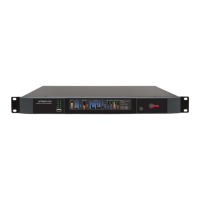Orban 5750 Technical Manual Operation 3-1
Section 3: Operation
Introduction to Processing
Some Audio Processing Concepts
Reducing the peak-to-average ratio of the audio increases loudness. If peaks are reduced, the average level can be
increased within the permitted modulation limits. The effectiveness with which this can be accomplished without
introducing objectionable side effects (such as pumping or intermodulation distortion) is the single best measure of
audio processing effectiveness.
Compression reduces the difference in level between the soft and loud sounds to make more efficient use of
permitted peak level limits, resulting in a subjective increase in the loudness of soft sounds. It cannot make loud
sounds seem louder. Compression reduces dynamic range relatively slowly in a manner similar to riding the gain:
Limiting and clipping, on the other hand, reduce the short-term peak-toaverage ratio of the audio.
Limiting increases audio density. Increasing density can make loud sounds seem louder, but can also result in an
unattractive busier, flatter, or denser sound. It is important to be aware of the many negative subjective side effects
of excessive density when setting controls that affect the density of the processed sound.
Clipping sharp peaks does not produce any audible side effects when done moderately. Excessive clipping will be
perceived as audible distortion.
Look-ahead limiting is limiting that prevents overshoots by examining a few milliseconds of the unprocessed sound
before it is limited. This way the limiter can anticipate peaks that are coming up.
The 5750 uses look-ahead techniques in several parts of the processing to minimize overshoot for a given level of
processing artifacts, among other things.
It is important to minimize audible peak-limiter-induced distortion when one is driving a low bitrate codec because
one does not want to waste precious bits encoding the distortion. Look-ahead limiting can achieve this goal; hard
clipping cannot.
One can model any peak limiter as a multiplier that multiplies its input signal by a gain control signal. This is a form
of amplitude modulation. Amplitude modulation produces sidebands around the “carrier” signal. In a peak limiter,
each Fourier component of the input signal is a separate “carrier” and the peak limiting process produces modulation
sidebands around each Fourier component.
Considered from this perspective, a hard clipper has a wideband gain control signal and thus introduces sidebands
that are far removed in frequency from their associated Fourier “carriers.” Hence, the “carriers” have little ability to
mask the resulting sidebands psychoacoustically. Conversely, a look-ahead limiter’s gain control signal has a much
lower bandwidth and produces modulation sidebands that are less likely to be audible.

